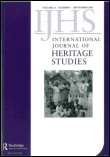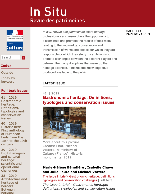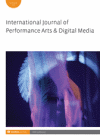
Archeomatica-Tecnologie per i Beni Culturali
metrics 2024
Exploring New Frontiers in Cultural Heritage Technologies.
Introduction
Archeomatica-Tecnologie per i Beni Culturali is a prestigious open-access journal dedicated to the field of cultural heritage technologies. Published by ARCHEOMATICA, this journal prides itself on disseminating high-quality research focused on innovative methodologies and technologies that enhance the preservation, conservation, and management of cultural assets. Since its inception in 2011, Archeomatica has fostered an inclusive platform for researchers, professionals, and students to share insights and advancements in the integration of science and technology within the cultural heritage sector. With a commitment to accessibility, all articles are freely available, promoting a collaborative academic environment. This journal is essential for those interested in bridging the gap between cultural heritage preservation and technological innovation, helping to ensure the longevity of our shared history.
Metrics 2024
 -
- -
- 0.10
0.10 -
-Metrics History
Rank 2024
JCI (Web Of Science)
Quartile History
Similar Journals

MUSEOLOGIA SCIENTIFICA
Advancing the Frontiers of MuseologyMUSEOLOGIA SCIENTIFICA is a distinguished journal dedicated to the study and advancement of museology, published by the ASSOCIAZIONE NAZIONALE MUSEI SCIENTIFICI in Italy. Focusing on a wide array of topics within the realm of science museums, the journal offers rich insights and research findings that shape the future of museum practices and education. Although currently not an open-access publication, MUSEOLOGIA SCIENTIFICA provides a vital platform for scholars, practitioners, and students interested in the preservation, curation, and display of scientific artifacts. By contributing to the discourse on innovative museum practices, the journal plays a crucial role in enhancing the professional standards within the field while promoting collaboration among museums worldwide. We invite researchers and practitioners alike to explore its valuable content, aimed at broadening understanding and knowledge in the ever-evolving landscape of museology.

International Journal of Heritage Studies
Fostering critical analysis in heritage conservation.Welcome to the International Journal of Heritage Studies, a prestigious publication dedicated to advancing knowledge in the fields of heritage conservation, cultural studies, and museology. Published by Routledge Journals, Taylor & Francis Ltd in the United Kingdom, this journal boasts an impressive impact ranking, positioned in the Q1 category for multiple disciplines, including Conservation and Cultural Studies, and a remarkable HIndex indicative of its influence within academia. With a history spanning from 1994 and continuing to 2024, the journal serves as an essential platform for researchers, professionals, and students aiming to contribute to the dynamic discourse surrounding heritage preservation and cultural management. Although the journal does not offer open access, it remains a vital resource for those interested in the nuanced intersections of heritage and society, as evidenced by its high ranks in various academic categories. The International Journal of Heritage Studies is committed to fostering innovative research and critical analysis in its field, inviting submissions that explore diverse methodologies and theoretical perspectives.

In Situ-Revue de Patrimoines
Championing open access to heritage research.In Situ-Revue de Patrimoines is a distinguished open-access journal published by the MINISTERE CULTURE & COMMUNICATION, dedicated to advancing the field of heritage studies. Established in 2001, this journal seeks to foster a deeper understanding of cultural heritage through the dissemination of high-quality research articles, reviews, and case studies that reflect the interdisciplinary nature of the discipline. With an ISSN of 1630-7305, In Situ provides scholars, practitioners, and students with invaluable insights into the preservation, management, and interpretation of cultural assets. By offering open access to its content, the journal ensures that vital knowledge in heritage conservation reaches a broad audience, promoting dialogue and collaboration within the global academic community. Situated in the heart of Paris, In Situ serves as an essential resource for those committed to the stewardship of our shared cultural legacy.

Investigacion Bibliotecologica
Pioneering Research for the Evolving World of LibrariesInvestigacion Bibliotecologica, published by the National Autonomous University of Mexico, stands as a vital resource in the field of library and information sciences. With a legacy of open access publishing since 1986, this journal endeavors to disseminate high-quality research which aims to advance knowledge and practices within the library and information sector. With an ISSN of 0187-358X and E-ISSN 2448-8321, it has secured its position in the competitive landscape of scholarly communication, earning a commendable Q3 ranking in its category as of 2023. The journal's influence is reflected in its Scopus ranking within the library and information sciences field, where it ranks #151 among 280 journals. Located in Mexico City, it provides scholars, professionals, and students with open access to its content, facilitating knowledge sharing and academic collaboration. As it continues its publication journey from 2008 to 2024, Investigacion Bibliotecologica remains an essential platform for innovative inquiries, practical insights, and the latest developments in library science.

Egyptian Journal of Archaeological and Restoration Studies
Innovating Restoration Practices for a Timeless Legacy.Welcome to the Egyptian Journal of Archaeological and Restoration Studies, a vital resource for scholars and practitioners in the field of archaeology and restoration. Published by the renowned SOHAG UNIV PUBLICATION CENTER-SUPC, this journal aims to disseminate cutting-edge research that illuminates the rich archaeological heritage of Egypt and beyond. With ISSN 2090-4932 and E-ISSN 2090-4940, this journal showcases innovative methodologies and interdisciplinary approaches, significantly contributing to our understanding of cultural heritage preservation. The journal's growing influence is reflected in its Q3 ranking in multiple categories, including Archaeology, Conservation, and Cultural Studies as of 2023, alongside its noteworthy placement within the Social Sciences. Open access options provide wider accessibility to essential studies, making it an indispensable tool for researchers, professionals, and students alike. Join us in exploring the past and shaping the future of archaeological scholarship.

Journal of Heritage Tourism
Illuminating the Past to Enrich the Future of TravelJournal of Heritage Tourism, published by Routledge Journals, part of Taylor & Francis Ltd, is a leading peer-reviewed journal dedicated to the interdisciplinary study of heritage tourism. As a vital resource for researchers, professionals, and students in the fields of History and Tourism, Leisure and Hospitality Management, this journal has consistently achieved high rankings, securing a Q1 quartile in History and Q2 in Tourism for 2023. With an impressive Scopus rank of #3 out of 1760 in Arts and Humanities - History and #42 out of 146 in Business - Tourism, it underscores the journal’s importance and relevance in contemporary scholarship. Spanning contributions from 2006 to 2024, the journal provides a platform for innovative research, critical discussions, and comprehensive analyses, fostering a greater understanding of the complex relationships between heritage and tourism. Although it does not currently offer open access, insights published within this journal remain accessible for institutional libraries and academic communities worldwide, ensuring that the ongoing discourse around heritage tourism flourishes.

Mediterranean Archaeology & Archaeometry
Exploring the Depths of Mediterranean HeritageMediterranean Archaeology & Archaeometry is a premier academic journal dedicated to advancing the fields of archaeology, anthropology, conservation, and history, published by UK Zhende Publishing Ltd. With its ISSN 1108-9628 and E-ISSN 2241-8121, this journal serves as a vital platform for scholars and practitioners to disseminate innovative research and findings related to the rich archaeological heritage of the Mediterranean region. It has gained remarkable recognition, achieving a Q2 ranking in anthropology and archaeology, and a Q1 classification in several categories including arts and humanities, conservation, and history as of 2023. Its impressive Scopus rankings underscore its impact, with a significant position in history (59/1760) and conservation (11/103) disciplines. Spanning years from 2008 to 2022, the journal invites open access contributions to foster collaboration and interdisciplinary dialogue among researchers, students, and professionals alike, making it an indispensable resource for those engaged in the exploration and preservation of historical narratives within the Mediterranean context.

International Journal of Performance Arts and Digital Media
Advancing Knowledge in Performance and Digital InnovationInternational Journal of Performance Arts and Digital Media, published by Routledge Journals, Taylor & Francis Ltd, stands at the forefront of interdisciplinary research encompassing the dynamic fields of performance arts and digital media. With an ISSN of 1479-4713 and an E-ISSN of 2040-0934, this esteemed journal has been a vital platform since its inception in 2005, highlighting significant contributions to both Visual Arts and Communication. As evidenced by its impressive rankings—Q1 in Visual Arts and Performing Arts and Q2 in Communication for 2023—the journal's high-impact research caters to a diverse audience, making it invaluable for academics, practitioners, and students alike. Though it follows a traditional subscription model and does not currently offer open access options, the International Journal of Performance Arts and Digital Media remains committed to publishing cutting-edge scholarship and critical dialogues that explore the intricate relationships between artistic expression and digital technologies. Its rigorous peer-review process ensures that all published works meet the highest academic standards, fostering an environment of innovation and creativity within its community.

Virtual Archaeology Review
Advancing the Future of Archaeology through Virtual Innovation.Virtual Archaeology Review, published by UNIV POLITECNICA VALENCIA, EDITORIAL UPV, is a distinguished open-access journal dedicated to the dynamic fields of archaeology and conservation. Based in Spain, this journal has made a significant impact in the academic community, reflected in its outstanding Q1 ranking in Archeology and Conservation for 2023, alongside impressive standings in related disciplines such as Computer Science Applications. With an active commitment to promoting the accessibility of knowledge since 2010, it provides a platform for researchers, professionals, and students to share innovative findings and methodologies in virtual archaeology, fostering collaboration across disciplines. The journal's impact factor and its strategic focus on advancing the practice of virtual methodologies in archaeology underscore its vital role in bridging technology and heritage studies. By embracing a multidisciplinary approach, Virtual Archaeology Review not only enhances academic discourse but also drives the development of effective conservation strategies, making it an essential resource for those dedicated to the preservation and appreciation of our cultural heritage.

Revista Eletronica Ventilando Acervos
Exploring the Frontiers of Archival ScienceRevista Eletronica Ventilando Acervos, with ISSN 2318-6062, is a pioneering academic journal published by the esteemed MUSEU VICTOR MEIRELLES-IBRAM, dedicated to the exploration and dissemination of research in the field of archival studies, museum studies, and heritage conservation. As an open-access journal, it provides unrestricted access to a wealth of scholarly articles, promoting the sharing of knowledge and innovative practices among researchers, professionals, and students alike. Situated in Florianópolis, Brazil, the journal not only showcases local research but also contributes to global discourse on cultural heritage and information management. With a vision to foster collaboration and dialogue within the academic community, Revista Eletronica Ventilando Acervos plays a pivotal role in enriching our understanding of archival science and its impact on society, making it an invaluable resource for anyone engaged in this dynamic field.